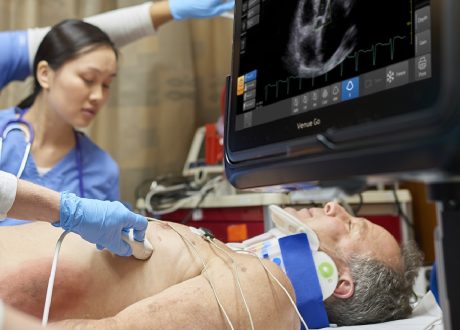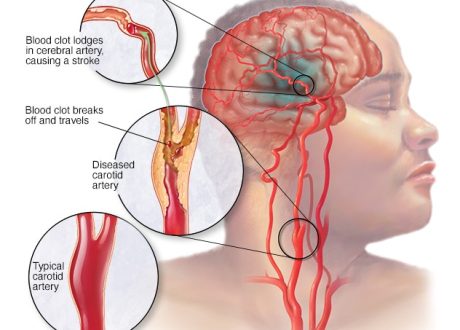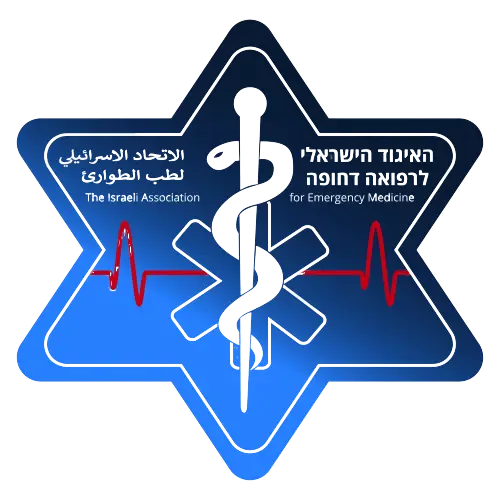Wilton A. van Klei, M.D., Ph.D., Michele D. Szabo, M.D., and Paul E. Hesterberg, M.D.
r. Yuefan Chen (Anesthesia, Critical Care, and Pain Medicine): A 59-year-old woman had hypotension and electrocardiographic (ECG) ST-segment abnormalities after the administration of anesthetic agents while she was in the operating room of this hospital.
Eighteen weeks before the current presentation, features of acromegaly were observed on routine physical examination by the patient’s primary care provider at another hospital. The blood level of insulin-like growth factor I (IGF-I) was 595 ng per milliliter (reference range, 50 to 317) and the growth hormone level 9.1 ng per milliliter (reference range, 0.0 to 7.1). The patient was referred to the endocrinology clinic of this hospital.
Eleven weeks before the current presentation, the patient was evaluated in the endocrinology clinic. She reported that her shoe size, which had been stable since young adulthood, had recently increased by two sizes. She also reported a deepening of her voice, fatigue, headaches, arthralgias, oily skin, skin tags, and acne on her face and back. She had had an intentional weight loss of 12.7 kg during the previous 9 months. The facial features were coarse, and there was no frontal bossing. Visual fields were full on confrontation testing. The tongue was thick and obscured the soft palate; the lower jaw was enlarged, with increased spacing between the teeth. The hands and feet were large and fleshy. Scattered skin tags were present on the neck. Auscultation of the heart and lungs revealed no abnormalities. Imaging studies were obtained.
Magnetic resonance imaging (MRI) of the head revealed a normal-sized pituitary gland with a well-circumscribed area of hypoenhancement that measured 9 mm by 7 mm by 10 mm. The patient was referred to the neurosurgery clinic of this hospital, and an elective microscopic transsphenoidal hypophysectomy was subsequently recommended.
Seven weeks before the current presentation, an extensive preoperative evaluation was performed, given the patient’s diagnosis of acromegaly. As part of the preoperative evaluation, additional history was obtained. The patient’s medical history included hypertension, prediabetes, obesity, obstructive sleep apnea, polycystic ovary syndrome, rheumatoid arthritis, osteoarthritis, and scoliosis. Physical activity was limited by pain in the knees; she could climb a flight of stairs but did so very slowly because of knee pain. She had no chest pain or dyspnea. Medications included hydrochlorothiazide, olmesartan, and ibuprofen and acetaminophen as needed for joint pain. Hydroxychloroquine had caused leukopenia, and meperidine had caused gastrointestinal upset. The patient lived in a rural area of New England with her husband and worked in an office. She did not smoke cigarettes or use illicit drugs; she drank alcohol rarely. Multiple maternal and paternal family members had cardiovascular disease.
ECG revealed sinus rhythm with nonspecific ST-segment and T-wave abnormalities, including a T-wave inversion in lead III. A transthoracic echocardiogram (TTE) showed normal left ventricular volume and systolic function, with a left ventricular ejection fraction of 55%, and there were no wall-motion abnormalities. The right ventricular volume and systolic function were normal; the estimated right ventricular systolic pressure was 28 mm Hg. Mild mitral regurgitation and tricuspid regurgitation were present. A pharmacologic stress test, with myocardial perfusion imaging performed after the administration of regadenoson, revealed no evidence of ischemia.
Three weeks before the current presentation, the patient was taken to the operating room for transsphenoidal hypophysectomy. The preoperative temporal temperature was 36.7°C, the heart rate 72 beats per minute, the blood pressure 131/69 mm Hg, and the oxygen saturation 97% while she was breathing ambient air. The body-mass index (the weight in kilograms divided by the square of the height in meters) was 35.7. Midazolam was administered, and anesthesia was induced with fentanyl, propofol, lidocaine, and rocuronium. Tracheal intubation was moderately challenging because of the presence of redundant tissue in the supraglottic region. During intubation, the oxygen saturation decreased to 79% but normalized in less than 1 minute. Inhaled sevoflurane (an anesthetic) and dexamethasone and piperacillin–tazobactam were administered, remifentanil and phenylephrine infusions were started, and the patient was placed in a level, supine position for the procedure.Intraoperative Vital Signs.

Intraoperative Telemetric Monitoring.
After the induction of anesthesia, before the surgical procedure was initiated, the blood pressure gradually decreased (Figure 1A). Sixteen minutes after induction began, the blood pressure was 96/48 mm Hg and the heart rate 75 beats per minute; 29 minutes after induction began, the blood pressure had decreased to 67/36 mm Hg and the heart rate to 71 beats per minute. Telemetric monitoring (Figure 2A) showed ST-segment elevations in the inferior leads and ST-segment depressions and T-wave inversions in the anterior and lateral leads. Aspirin was administered rectally, the rate of the phenylephrine infusion was increased, and multiple boluses of phenylephrine and an ephedrine bolus were administered. The blood pressure increased to 110/54 mm Hg and the heart rate to 111 beats per minute. Telemetric monitoring showed resolution of the ST-segment and T-wave abnormalities. Findings on ECG and transesophageal echocardiography (TEE) performed in the operating room were consistent with those of the preoperative ECG and TTE. The procedure was aborted, the patient was weaned from the vasopressor therapies, and the trachea was extubated. She was transferred to the cardiac intensive care unit.

Laboratory Data.
On admission to the cardiac intensive care unit, the blood level of troponin T was 10 ng per liter (reference range, 0 to 9); 1 hour later, the level had decreased to 8 ng per liter. Other laboratory test results are shown in Table 1. Chest radiography was normal. Computed tomographic angiography of the coronary arteries revealed moderate stenosis of the distal left anterior descending coronary artery. The intraoperative ST-segment elevations were attributed to coronary vasospasm. Treatment with amlodipine and isosorbide mononitrate was initiated for coronary vasospasm, and treatment with atorvastatin was started for nonobstructive coronary artery disease. After discussion among the cardiology, neurosurgery, and anesthesia teams, it was determined that the patient remained a candidate for transsphenoidal hypophysectomy, particularly because the surgery could offer a cure for her acromegaly; the procedure was rescheduled. The patient was discharged home on the third hospital day.
During the subsequent 3 weeks, the patient continued taking the newly prescribed medications, and no new symptoms developed. On the day of the current presentation, she was again taken to the operating room to undergo transsphenoidal hypophysectomy. The preoperative blood pressure, as measured through an arterial catheter, was 118/67 mm Hg and the heart rate 88 beats per minute. Sedation with fentanyl and midazolam was started, topical lidocaine was used to anesthetize the airways, and fiberoptic tracheal intubation was performed while the patient was awake. Anesthesia was then induced with propofol, rocuronium, and sevoflurane. A phenylephrine infusion was started, and piperacillin–tazobactam was administered.
The blood pressure decreased abruptly to 54/29 mm Hg (Figure 1B). Telemetric monitoring (Figure 2B) showed ST-segment elevations in the inferior leads and ST-segment depressions and T-wave inversions in the anterior and lateral leads.
Management decisions were made, and a diagnostic test was performed. ![]()










